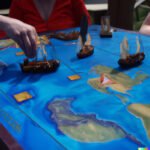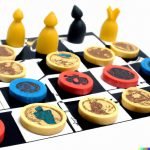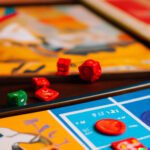Introduction
Board games are classic activities that have been enjoyed around the world for centuries. From cards to dice and chess, these beloved forms of entertainment have changed drastically over the years. Although the basic concepts stay the same, the visuals on each board game has been modified many times as new materials, styles, and themes have become available. Images of board games can take many forms depending on the style and intended audience. They may feature colorful cartoon characters or more realistic artworks depicting life-like figures, animals, or imaginary creatures. Scenes from popular films or books may also appear on different boards games in order to add a unique and iconic flair to a particular title. Aside from graphical elements, text is also commonly featured on boards games in order to provide clear instruction or further add to the atmosphere that a given game is trying to create. In essence, even a very simple board game can convey an incredible amount of content just through its images alone.
Popular Types of Board Games
Board games are a timeless, classic way to pass the time. From children to adults, everyone can enjoy the strategic twists and turns of a board game. Some of the most popular types include classic strategy-based games such as chess, checkers, and Go; card-based strategy games such as poker, blackjack and Uno; adventure-style games such as Clue; and family favorites like Monopoly and Trivial Pursuit. Many board games also have now have video game versions for added convenience. Other variants of board games include wargames, co-operative (multiplayer) games, deduction or mystery solving games, race and chase stylegames, among many others. Board game clubs are becoming increasingly popular around the world where gamers from all walks of life can come together to play their favorite boardgames with friends or strangers alike. It’s a great way to reconnect with family during the holidays or just make some new friends!
Historic Origins of Board Games
Board games have been a well-loved form of family entertainment for centuries. The earliest board games believed to have originated in 4000 BC and were found in ancient ruins across the Middle East, specifically in what is now Iraq, Syria, and Palestine. These artifacts indicate that they were used as a way of teaching social skills such as counting, strategy, and luck. As Board games spread throughout the world they continued to evolve; Ancient Egyptian versions included weaved cloth boards and wooden pieces ” one of these being Senet which is thought to be the first recorded game of strategy. Through trade and travel, board games have flourished into different regions creating regionalized variants such as Chinese Checkers and Mancala across Africa. As time progressed board games became accessible to more people with materials becoming otherwise available such as paper with which chess was played. In modern day there are thousands of different board games ranging from strategy based ones like Risk to party-style like Cards Against Humanity and everything in between. Board games provide entertainment timelessly throughout all generations ” proving their continuous popularity over personal technology since its inception.
Enhancing Board Games Through Visual Design
Since the invention of board games hundreds of years ago, their visual designs have been an essential part of their appeal. Adjusting the aesthetics of a board game can drastically change how players perceive and experience the gameplay. The colors, illustrations, symbols, and artwork all have an influence on arousing curiosity for a new game and conveying the tone or theme to be expected.
When it comes to board game visual design, color is one of the most important elements as it offers a sense of familiarity to those familiar with the traditional games while also providing an exciting pop necessary to capture viewers’ attention. Colors should be used strategically in order to transport players into the world created by the game designers. As well as colors, having strong visuals such illustrations and artwork helps tell stories that are both captivating and useful in terms of representing actions or visuals needed for players’ understanding. It is no surprise that many popular board games focus heavily on cartoonish art like The Settlers of Catan or Euro-style illustrations like Carcassonne or character designs like Pandemic. They use these art styles intentional because they evoke certain emotions from players which helps manipulate desire associated with playing each game.
Besides producing interesting visuals, having well-designed components also impacts how enjoyable playing a board game can be. Some companies offer wooden tokens or other materials which provide a nice tactile interaction between players that add another layer to playing each turn as well as overal thrill experienced during gameplay itself. It is really worth considering how much work goes into creating these tactile pieces after all they are going to make-or-break some players’ decisions whether they want purchase a game solely based on how they feel while they hold them in their hands.
Board Game Graphics of the Past and Present
In years past, board game graphics were far less sophisticated than they are in modern times. In the late 1800s and even up to the 1950s, many board game boards and pieces were printed with basic colors or black and white artwork. Very little detail was put into these games, and it wasn’t until the 1960s that the first three-dimensional pieces”like chess sets or Monopoly houses”were available. As technology advanced, so did board game graphics: during the 1970s, plastic pieces began to be used for a more realistic look; then, in the 1990s, computer-generated images allowed for a level of detail never before seen on a board game box.
Today’s board games feature some of the most visually stunning designs ever created . New technologies include 3D printing which allows intricate designs to be made at home using an ordinary printer. Customized pieces such as magnetic tiles and moveable figurines add even more detail to traditionally plain boards. Many newer games incorporate color-changing pieces or brightly colored LCD screens. From vibrant cartoon characters to fully immersive fantasy worlds – there’s something for everyone when it comes to modern board game graphics!
Creative Ways to Incorporate Images Into Board Games
One way to incorporate images into board games is by making the game pieces images. You could use cards or 3-dimensional tokens that depict characters, animals, places, or objects related to the game’s theme or story. Players can collect and use these images to accomplish various tasks in the game, such as earning points, navigating a board, trading or exchanging items, or completing challenges. Another option is to make the board itself a large image that conveys a story or sets the mood for the game. Depending on the complexity of your board game and what kinds of tasks you’d like players to accomplish, you may even be able to use digital images instead of physical pieces for certain actions. Digital components might integrate well with an augmented reality-based augmented reality (AR) format for certain sections of play. Finally, artwork used for character depictions and background scenes can act as attractive decorative elements that bring an extra level of life and vibrancy to a game design.
Developmental Benefits of Images and Board Games for Kids
Board games provide an incredibly valuable opportunity for kids to learn the fundamentals of logic, rule following, communication, problem solving, strategy, social skills and more. In recent years, a growing number of parents have turned to board games as part of their children’s healthy development by factoring them into home-based educational plans as well. The visuals associated with these activities can also be crucial in helping younger children memory recall concepts they’re being taught and make associations between ideas that is far less likely to happen when only letters and words are used. When the symbols are iconic – like images from popular stories or recognizable objects from everyday life – those visual cues become shortcuts for helping children understand the game dynamics more quickly. Additionally, visual stimuli could tap into a child’s creative side by sparking imaginative play during board-game session rather than just memorizing rules. Kids should always have association/assimilation of facts through fun activities such as board games. Moreover, beyond comprehension skills are other benefits. Playing board games encourages collaboration with children of same age groups and adults alike. Visual information can also assist players in understanding scoring and turn taking more readily; Plus it eliminates long-winded descriptions which can disrupt meaningful conversation while playing the game. Last but not least, family bonding time is hugely improved though inclusion of visual cues during board game nights!
Image Inspiration for Board Gaming Projects
When working on board gaming projects, it can be helpful to have a variety of images that serve as inspiration. Images might include colorful artwork, illustrations, or family-friendly photographs. These visuals can help spark creativity for game designs and components, such as board game pieces, action cards, tokens, dice, spinners, and more. For example, if you’re creating a fantasy-themed board game with dragons and castles, illustrations of these objects could provide some visual guidance on how various elements of the game should look.
In addition to using image inspiration to create the components of your board games project, they can also help to generate ideas for concepts and storylines. Perhaps you’re stuck trying to come up with an exciting way to play out a story within your game – taking some time to look through pictures can be great source of inspiration. Photos or pictures may give you new ideas about pieces that are needed or story lines that could be incorporated into your project. Alternatively, images may remind you of gameplay dynamics that haven’t been explored in other popular games yet but could create a fun concept for your own design.
An Analysis of Board Game Images
Research from the past few decades has shown that board game imagery has changed significantly over time. Images of people playing or enjoying board games have been used to promote both physical and digital versions of popular board games, while artwork depicting classic board game characters has evolved throughout the years with modernity. Colorful, imaginative portrayals of boards, pieces, tokens, and dice have become associated with the excitement and challenge of these beloved games. Moreover, more recent iterations often feature graphical designs that are both attractive and meaningful in terms of conveying a deeper narrative.
To better understand how imagery has changed over time, researchers have categorized these images into various categories such as scenery-based representations (e.g., landscapes or seascapes), character-based images (e.g., classic board game icons such as Monopoly’s Rich Uncle Pennybags or Scrabble’s Mr.Scrabble), product-focused artwork (e.g., pictures of actual pieces or boxed sets), simple sketches (e.g., outlines of components for assembling a game). Each category is distinct in terms of its visual style and content; however, other common elements exist amongst them all: stylized typefaces, eye-catching colors and patterns, clean lines and shapes, cohesive compositions for larger multi-piece boards ” all working to visually unify theme and gameplay components into one distinct look and feel for potential customers to recognize when seeing any representation at retail stores or online advertisements.
Furthermore, various advancements in technology have allowed developers to create photorealistic 3D simulations of their own game environments which adds an entirely new layer to the visuals they are able offer consumers through vastly improved graphics quality that can almost emulate real life game play experiences without actually being there! By utilizing 3D renderings, developers are now able to illustrate details with great accuracy while leaving room for further refinement down the line if needed; thus allowing more opportunities for creation/thematic tweaks before release which will ultimately give customers a better experience when playing their favorite titles at home or on their mobile devices anytime they choose!
Conclusion
The ancient board game images that fill our modern memories remind us of a time when digital distractions were not prevalent. They evoke nostalgia and the old-fashioned values of simpler times. Board games have been around for centuries, with simple designs that have evolved over time to reflect societal changes and technological advancements. From archaeological remains to the hallowed halls, it is clear that these special images have been an integral part of history. As generations pass, board game images remain part of our collective culture and history; they represent joy from long ago and a continuation of a timeless tradition, clinging to their place in an ever-changing world. In their presence, we can take solace from their familiarity as well as realize importance in preserving the past for future generations.

I love playing all kinds of games – from classics like Monopoly to modern favourites like Ticket to Ride.
I created this blog as a way to share my love of board games with others, and provide information on the latest releases and news in the industry.





